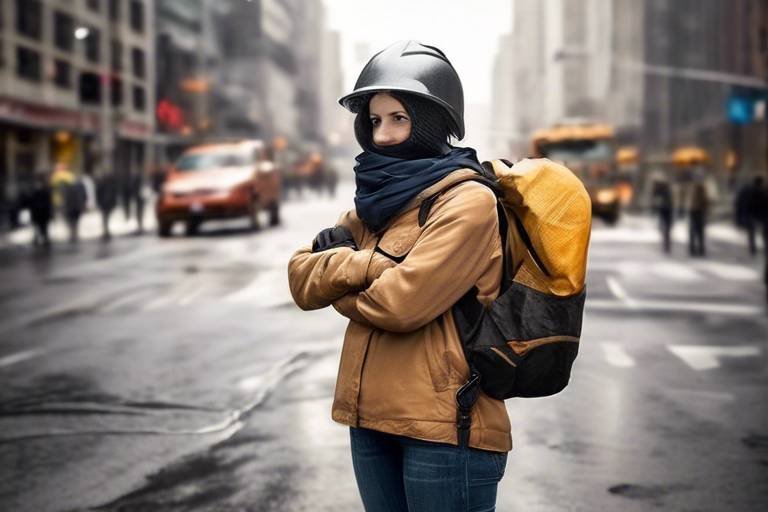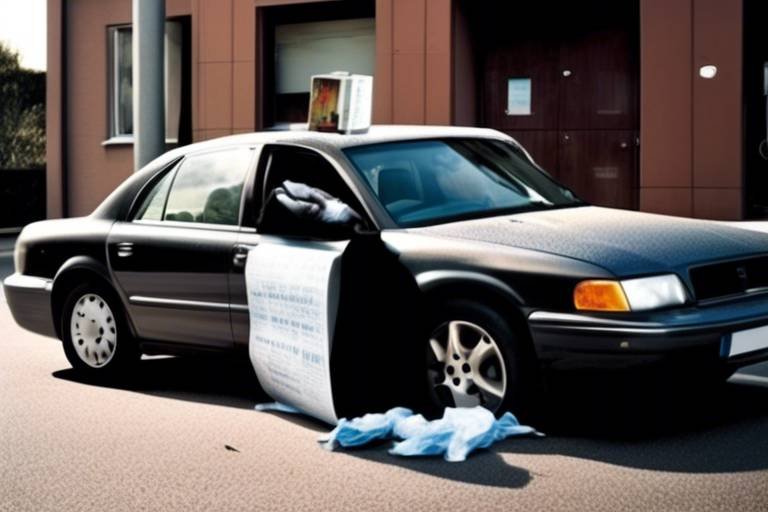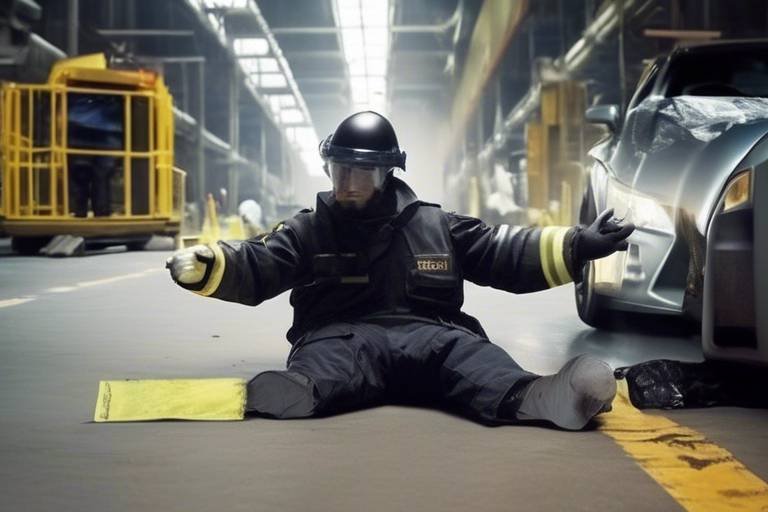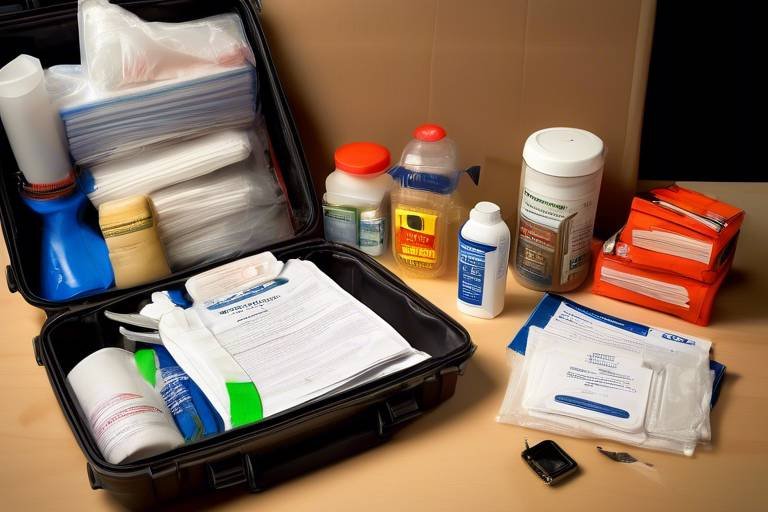Safety Tips for Windy Weather
When the winds start to howl and the trees sway, it’s time to take a moment and think about safety. Windy weather can be exhilarating, but it can also be dangerous if you're not prepared. Just like a roller coaster ride, it can be thrilling, but you wouldn't want to go without the safety harness, right? In this article, we’ll dive into essential safety measures to take during windy weather, covering everything from preparation and travel precautions to securing your property against strong gusts. So, buckle up and let’s get started!
First things first, let’s talk about the potential dangers that come with high winds. Recognizing these hazards is crucial for your safety. Imagine walking down the street when suddenly, a branch flies past your head like a missile! Falling debris, such as branches, signs, and even parts of buildings, can pose serious threats during windy conditions. Additionally, high winds can lead to power outages, leaving you in the dark and potentially without heat or food. It's not just about the wind itself; it's about what it can carry and the havoc it can wreak on your surroundings.
Now that you understand the risks, let’s focus on how to prepare your home for windy weather. Think of your house as a fortress; you wouldn’t want to leave the gates unguarded, would you? Start by reinforcing windows and doors. You can use storm shutters or plywood to protect glass from breaking. Check your roof for loose shingles and secure any outdoor structures, like patio furniture or garden decorations. If you have large trees nearby, consider consulting a professional to assess their stability. Remember, a little preparation can go a long way in minimizing damage.
Traveling during windy weather can feel like navigating a ship through choppy waters. It’s essential to stay alert and cautious. If you're driving, keep both hands on the wheel and reduce your speed, especially if you're in a high-profile vehicle like a truck or SUV. Strong gusts can easily push these vehicles off course. For those biking or walking, avoid open areas and be mindful of your surroundings. Look out for falling branches or debris. Always have a plan in place for where you can take shelter if conditions worsen.
Let’s not forget about those outdoor items that can easily turn into dangerous projectiles. Picture your lawn chair soaring through the air like a frisbee! To prevent this, secure or store outdoor furniture, decorations, and equipment before the winds hit. Bring in anything lightweight, and for larger items, consider using weights or straps to keep them grounded. This simple step can save you from potential accidents and damage.
Being prepared for emergencies is like having a safety net when you’re walking a tightrope. It’s essential to have an emergency kit ready, stocked with essentials such as water, non-perishable food, flashlights, batteries, and a first-aid kit. Additionally, have a plan for power outages, including how to safely use generators and conserve energy. It’s always better to be over-prepared than underprepared!
Understanding weather alerts and warnings is key to staying safe during windy weather. Pay attention to local forecasts and advisories. When you hear terms like “high wind warning” or “wind advisory,” take them seriously! These alerts are your cue to take action. Make sure you know what to do when severe weather is forecasted. It’s like having a map before embarking on an adventure; it helps you navigate through the storm.
Power outages are a common occurrence during windy weather, and being prepared can make all the difference. If the lights go out, stay calm and remember your emergency kit. Use flashlights instead of candles to reduce fire risks. If you have a generator, ensure it's set up outside and away from windows to avoid carbon monoxide poisoning. Conserve energy by unplugging unnecessary appliances and keeping refrigerator doors closed to maintain cool temperatures.
After the winds have calmed down, it’s time to assess any damage. Just like a doctor checks a patient after surgery, you need to inspect your property for hazards. Look for downed power lines, broken branches, and any structural damage. If you notice anything dangerous, report it to the authorities. Only return to normal activities once you’re sure everything is safe. Remember, safety first!
- What should I do if I’m caught outside in high winds? Seek shelter immediately and stay away from trees and power lines.
- How can I secure my outdoor furniture? Use weights, straps, or bring them inside if possible.
- What items should I include in my emergency kit? Water, non-perishable food, flashlights, batteries, and a first-aid kit are essential.

Understanding Wind Hazards
When the winds start to howl, it’s not just a scene from a horror movie; it’s a reality that can bring serious hazards right to your doorstep. Understanding these wind hazards is crucial for your safety and the safety of those around you. High winds can lead to a variety of dangerous situations, including falling debris, which can transform everyday objects into lethal projectiles. Imagine a tree branch snapping off and flying through the air like a javelin; that’s the kind of unpredictability we’re talking about!
Additionally, strong winds often result in power outages. When trees fall on power lines or when wind speeds exceed safe operational limits for power infrastructure, it can leave your home in the dark. This is not just an inconvenience; it can pose serious risks, especially if you rely on electricity for medical devices or heating during cold weather. So, how can you prepare for these potential hazards?
First off, it’s essential to recognize the types of wind hazards you might face. Here’s a quick breakdown:
- Falling Trees and Branches: High winds can uproot trees or break branches, which can fall onto homes, vehicles, or even people.
- Flying Debris: Items that are not secured can become dangerous projectiles, causing injury or damage.
- Power Outages: As mentioned, strong winds can disrupt power lines, leading to outages that can last hours or even days.
- Structural Damage: Homes and buildings can suffer damage to roofs, windows, and siding due to intense wind pressure.
By understanding these hazards, you can take proactive steps to minimize risks. For example, knowing that falling trees are a significant concern might prompt you to trim overhanging branches or even remove unstable trees from your property. Furthermore, staying informed about weather forecasts and wind advisories can help you prepare for impending storms.
In summary, recognizing and understanding wind hazards is the first step in ensuring your safety during windy conditions. By being aware of what can happen and preparing accordingly, you can protect yourself, your family, and your property from the unpredictable nature of high winds. So, the next time you hear that wind picking up, take a moment to think about what you can do to stay safe!

Preparing Your Home
When it comes to windy weather, preparation is your best friend. Imagine the chaos that can ensue if you're caught off guard by strong gusts. It's like being in a movie where the storm hits and everything goes haywire! So, let’s take a moment to think about how we can safeguard our homes and loved ones. First and foremost, securing your windows and doors is crucial. Consider installing storm shutters or using plywood to board up your windows. This not only prevents glass from shattering but also keeps debris from flying into your home.
Next, let’s talk about your roof. If you live in an area prone to high winds, it’s wise to ensure that your roof is in good condition. Check for loose shingles or tiles and replace them as needed. A well-maintained roof can withstand the elements much better than a neglected one. And don’t forget about your gutters! Make sure they are clear of debris to avoid water damage when the rains come after the winds.
It’s also essential to secure outdoor structures. Think about your patio furniture, garden decorations, and any equipment you might have outside. You don’t want that lovely garden gnome turning into a projectile! Store lightweight items in your garage or shed, and for heavier furniture, use tie-downs or weights to keep them anchored. If you have larger items like trampolines or canopies, consider disassembling them or moving them to a more sheltered area.
Furthermore, don’t overlook your trees! Inspect your property for any trees that look unhealthy or are leaning precariously. It’s better to take action before a branch comes crashing down on your roof or car. If you’re unsure, hiring a professional to assess and trim trees can save you a lot of headaches later on.
Finally, let’s talk about the inside of your home. Ensure that you have a safety kit ready, stocked with essentials like water, non-perishable food, flashlights, batteries, and a first-aid kit. This kit is crucial for any emergency, especially if you find yourself without power for an extended period. Having everything in one place means you won't be scrambling around when the winds start howling.
By taking these precautions, you’re not just protecting your property; you’re also ensuring the safety of your family. Remember, preparation is key! It’s like putting on a seatbelt before driving—sometimes it feels unnecessary, but when the unexpected happens, you’ll be glad you did.
- What should I do if I can't board up my windows? If boarding up isn’t possible, use heavy-duty tape in an 'X' pattern to help prevent shattering.
- How can I secure my outdoor furniture? Use weights or tie-downs, and if possible, store them in a garage or shed.
- What items should be included in my emergency kit? Include water, non-perishable food, flashlights, batteries, and a first-aid kit.
- How do I know if my trees need trimming? Look for dead branches, signs of disease, or trees that lean too close to your home.

Traveling Safely in Windy Conditions
When the winds pick up, it’s not just the trees swaying that you need to worry about; it’s how those gusts can affect your travel plans. Whether you’re driving, biking, or even walking, understanding how to navigate windy conditions is crucial for your safety. Imagine trying to steer a ship through choppy waters—without the right skills, you could easily find yourself in a precarious situation. Wind can create unexpected challenges, so let’s dive into some essential tips to keep you safe on the go.
First and foremost, if you’re driving, it’s vital to adjust your driving style to match the conditions. High winds can make your vehicle feel like it’s being pushed around on the road. It’s like trying to balance on a tightrope; one wrong move can send you tumbling. Here are a few driving tips:
- Keep both hands on the steering wheel: This gives you better control over your vehicle, especially when strong gusts hit.
- Reduce your speed: Slowing down can help you react more effectively to sudden wind shifts.
- Be cautious around larger vehicles: Trucks and buses can create wind tunnels that affect your vehicle’s stability.
- Maintain a safe distance: This gives you time to react if another driver is caught off guard by the wind.
But it’s not just drivers who need to be cautious. If you’re biking, the wind can feel like an adversary, pushing you off course. When cycling in windy weather, consider the following:
- Position your body strategically: Lean slightly into the wind to maintain balance.
- Choose your route wisely: Opt for paths that are sheltered from the wind, such as those lined with trees or buildings.
And let’s not forget about pedestrians! Walking in windy conditions can be tricky, especially if debris is flying around. Always be aware of your surroundings and avoid areas with loose branches or signs that could potentially become projectiles. It’s like playing dodgeball, but instead of balls, you’re dodging nature’s unexpected surprises!
In addition to these tips, it’s essential to stay updated on weather conditions. Before heading out, check local forecasts or use weather apps to gauge wind speeds and advisories. Knowing what to expect can make all the difference. If conditions seem severe, it might be best to postpone your travel plans altogether. After all, there’s no prize for braving the storm when safety is at stake.
Lastly, remember that preparation is key. If you know you’ll be traveling in windy conditions, ensure your vehicle is in good shape—check your tire pressure and ensure your brakes are functioning correctly. If you’re biking, make sure your tires are inflated and your brakes are responsive. Just like a well-tuned instrument, a properly maintained vehicle or bike will perform much better when the winds start howling.
In summary, traveling safely in windy conditions requires a mix of awareness, preparation, and adaptability. By following these tips and staying alert, you can navigate through gusty weather with confidence, ensuring you arrive at your destination safely. Remember, the wind may be strong, but with the right strategies, you can stay even stronger!
Q: What should I do if I encounter strong winds while driving?
A: If you encounter strong winds, reduce your speed, keep both hands on the wheel, and maintain a safe distance from other vehicles. If conditions are too severe, find a safe place to pull over until the winds subside.
Q: Is it safe to ride my bike in windy conditions?
A: Riding a bike in windy conditions can be safe if you take precautions. Lean into the wind for balance, choose sheltered routes, and be aware of your surroundings.
Q: How can I prepare my vehicle for windy weather?
A: Ensure your vehicle is well-maintained, check your tire pressure, and make sure your brakes are functioning properly before heading out in windy conditions.

Protecting Outdoor Items
When the winds start howling and the trees begin to sway, it’s time to take a closer look at your outdoor items. You might not realize it, but those seemingly harmless garden gnomes or patio chairs can turn into dangerous projectiles if left unsecured during windy weather. Imagine a lightweight chair soaring through the air like a paper airplane, potentially causing damage to your property or, even worse, injuring someone. To prevent such scenarios, it's essential to take proactive measures to protect your outdoor belongings.
First and foremost, consider the materials of your outdoor items. Heavy, sturdy furniture is less likely to be blown away than lightweight plastic or metal pieces. If you have items that can easily be moved, such as planters, umbrellas, and decorative sculptures, these should be your top priority when securing your yard. If you can, bring them indoors or into a sheltered area. If that’s not feasible, using weights or ties can help anchor them down.
For larger items like patio tables or grills, you can take a few simple steps to ensure they stay put. Here are some effective strategies:
- Use Weights: Attach weights to the legs of lighter furniture. Sandbags or bricks can work wonders.
- Secure with Ties: Use bungee cords or straps to tie down larger items to a stable structure, like a fence or a heavy tree.
- Store in a Shed: If you have a garden shed or garage, store your outdoor items inside during stormy weather.
Additionally, consider the layout of your yard. If you have a fence, it can act as a windbreak, helping to reduce the impact on your outdoor items. However, if you don’t have a fence, think about arranging your furniture in a way that minimizes exposure to direct wind. For instance, placing larger items in front of smaller ones can create a protective barrier. It's like a game of Tetris—fit everything together to create a solid defense against the wind!
Lastly, don't forget about your outdoor decorations. Items like string lights or hanging planters can easily be swept away. Consider removing these items or securing them to ensure they don’t become casualties of the wind. If you have garden decorations that are particularly valuable or sentimental, it’s best to bring them inside until the storm passes.
In summary, protecting your outdoor items during windy weather is all about foresight and preparation. By taking the time to secure your belongings, you can avoid costly damages and keep your yard safe. Remember, a little effort goes a long way in safeguarding your outdoor investments!
Q: What should I do if I can't bring my outdoor furniture inside?
A: If bringing your furniture inside isn't an option, consider using heavy weights or tying them down securely. You can also position them against a sturdy fence or wall to minimize exposure to the wind.
Q: Are there specific types of outdoor furniture that are more wind-resistant?
A: Yes! Heavier materials like wrought iron or solid wood are generally more resistant to wind than lightweight plastic or aluminum. Look for furniture designed for high winds if you live in a windy area.
Q: How can I protect my garden decorations during windy weather?
A: Remove any loose decorations and store them indoors. For items that can't be moved, consider securing them with ties or weights to prevent them from being blown away.

Emergency Preparedness
When the winds start to howl and the trees sway ominously, it's not just a scene from a horror movie—it's a reminder that **emergency preparedness** is not just smart; it's essential. Think of it as your safety net, ready to catch you if the storm throws you off balance. Being prepared can mean the difference between chaos and calm when high winds hit your area. So, what exactly should you do to ensure you're ready?
First and foremost, creating an emergency kit is crucial. This kit should be stocked with all the essentials you might need during a power outage or severe weather event. Imagine being stuck at home without power—how would you keep your family comfortable and safe? Here’s what to include in your emergency kit:
- Water: At least one gallon per person per day for at least three days.
- Non-perishable Food: Enough to last at least three days, think canned goods, granola bars, and dried fruits.
- Flashlights: With extra batteries, because when the lights go out, you want to illuminate your way.
- First Aid Kit: Accidents can happen, so be prepared to handle minor injuries.
- Whistle: A whistle can be a lifesaver if you need to signal for help.
- Multi-tool: This handy gadget can assist in various situations.
Now that your kit is ready, it's time to think about your **emergency plan**. Gather your family and discuss what steps to take if a severe weather warning is issued. Where will you meet if you need to evacuate? How will you communicate if the power goes out? These questions are vital to ensure everyone is on the same page. Consider creating a designated safe room in your home—somewhere away from windows where you can gather during the storm.
Additionally, it's wise to stay informed about the weather. Use reliable sources like local news channels or weather apps to keep track of any changes. **Knowledge is power**, and being aware of impending weather conditions allows you to act swiftly and efficiently. Set up alerts on your phone to notify you of any severe weather warnings. This way, you won’t be caught off guard.
Lastly, don’t forget about your pets! They are part of your family too, and they need to be included in your emergency plan. Make sure you have food, water, and a safe space for them during windy weather. It’s also a good idea to have a pet carrier handy in case you need to evacuate quickly.
In summary, emergency preparedness during windy weather is about more than just having supplies; it’s about creating a comprehensive plan that keeps you and your loved ones safe. By taking these proactive steps, you can face the storm with confidence, knowing that you are ready for whatever Mother Nature throws your way.
Q: What should I do if I hear a weather warning?
A: Take it seriously! Gather your emergency kit, secure loose items outside, and follow your emergency plan.
Q: How often should I check my emergency kit?
A: It’s a good idea to check your kit at least twice a year, especially before hurricane season or other storm-prone periods.
Q: Can I use my car as a shelter during high winds?
A: It’s generally safer to stay indoors, but if you’re caught outside, your car can provide some protection. Just avoid parking under trees or power lines.

Recognizing Warning Signs
When it comes to windy weather, being proactive can mean the difference between safety and disaster. But how do you know when the winds are about to pick up and pose a threat? Recognizing the warning signs is crucial for staying safe during these blustery conditions. For starters, pay attention to local weather forecasts. Meteorologists use a variety of tools to predict wind speeds and potential hazards, so keeping an ear out for updates can provide valuable insights.
One of the most common indicators of impending windy weather is the issuance of warnings and advisories from your local weather service. These alerts can range from simple wind advisories to more serious warnings about damaging winds. Here’s a quick breakdown:
| Alert Level | Description |
|---|---|
| Wind Advisory | Winds of 20 to 30 mph are expected, with gusts up to 45 mph. |
| High Wind Warning | Winds of 40 mph or more are expected, which can cause significant damage. |
| Severe Thunderstorm Warning | Severe thunderstorms can produce damaging winds, often exceeding 60 mph. |
Additionally, nature itself often gives us clues about the weather. Have you noticed trees swaying more than usual or the sound of branches creaking? These can be indicators that the wind is picking up. Animals may also behave differently; birds often seek shelter during strong winds, and you might see them flying low or not at all. Trust your instincts—if it feels like the wind is picking up, it probably is!
Another aspect to consider is the visual cues around you. Dark clouds rolling in can signify an approaching storm, which often brings strong winds. If you see clouds moving quickly across the sky, it’s a sign that wind speeds might be increasing. It's crucial to stay alert and not ignore these signs, as they can help you take necessary precautions before the winds become dangerous.
Lastly, understanding wind patterns in your area can help you prepare better. If you live in a region known for sudden gusts, it’s wise to keep a close watch on the weather. Knowing your environment allows you to anticipate changes more accurately. So, whether it’s securing outdoor items or staying indoors, being aware of the warning signs can save you from harm.
- What should I do if a wind advisory is issued? It's best to stay indoors, secure outdoor items, and avoid unnecessary travel.
- How can I find out about local weather warnings? You can check your local news station, weather apps, or the National Weather Service website.
- What are the dangers of high winds? High winds can cause falling branches, flying debris, and power outages, posing risks to safety.

Dealing with Power Outages
Power outages can be a frustrating and unsettling experience, especially during windy weather when the risk of losing electricity increases significantly. Imagine being in the middle of your favorite TV show or cooking dinner when suddenly, the lights flicker and go out. It’s like a scene straight out of a suspense movie! But fear not; with a little preparation and knowledge, you can navigate through these outages smoothly.
First and foremost, it’s essential to have a plan in place before the winds start howling. **Preparation is key!** Start by assembling an emergency kit that includes essential items such as flashlights, batteries, non-perishable food, and bottled water. You wouldn’t want to be rummaging through your drawers in the dark, right? Here’s a quick checklist to help you out:
- Flashlights and extra batteries
- Battery-operated radio
- First aid kit
- Non-perishable food items
- Bottled water (at least one gallon per person per day)
- Medications and necessary medical supplies
Once your kit is ready, it’s also wise to think about how to keep your food safe during an outage. The U.S. Department of Agriculture (USDA) recommends that you keep your refrigerator and freezer doors closed as much as possible. A full freezer can keep food frozen for about 48 hours, while a half-full freezer will last about 24 hours. If you’re ever in doubt about whether food is still safe to eat, remember this golden rule: “When in doubt, throw it out!”
Now, let’s talk about safety. Generators can be a lifesaver during power outages, but they also come with risks. Make sure to use them outside and away from windows to prevent carbon monoxide poisoning. If you’re unsure about how to operate a generator safely, it’s worth investing some time in learning the basics. Always read the manufacturer’s instructions and follow safety guidelines. Think of it as your generator’s way of saying, “I’m here to help, but let’s do this safely!”
Moreover, conserving energy is crucial during an outage, especially if you’re using a generator. Turn off unnecessary appliances and lights to extend the life of your power supply. You can also use energy-efficient LED lights and unplug devices that you’re not using. It’s like giving your generator a little break, allowing it to work longer without straining itself.
Lastly, stay informed. Keep a battery-powered radio or a charged mobile device handy to receive updates about the power outage and weather conditions. Knowing what’s happening outside can help you make informed decisions. You might even want to check in with your neighbors to see if they’re experiencing the same issues and share resources if needed. After all, it’s always better to weather the storm together!
Q: How long can food last in the refrigerator during a power outage?
A: Generally, food can last in the refrigerator for about 4 hours if the door remains closed. After that, it’s best to check the temperature and the food’s safety.
Q: Can I use my generator indoors?
A: No, using a generator indoors or in enclosed spaces is extremely dangerous due to the risk of carbon monoxide poisoning. Always use it outdoors, far away from windows and vents.
Q: What should I do if I see downed power lines?
A: Stay away from downed power lines and report them to your local utility company immediately. Treat all downed lines as if they are live and dangerous.

Post-Wind Safety Checks
After the winds have calmed down and the skies clear, it’s easy to breathe a sigh of relief and think everything is back to normal. But hold on! The aftermath of windy weather can often be as hazardous as the event itself. Just like a roller coaster that leaves you breathless, the thrill of strong winds can also leave behind a trail of destruction that requires your attention. So, what should you do once the storm has passed? Let's dive into the essential post-wind safety checks that you should perform to ensure your home and surroundings are safe.
First and foremost, take a stroll around your property to inspect for any visible damage. Look for fallen branches, debris, or even structural damage to your home. Just like a doctor conducts a thorough examination, you need to ensure every part of your property is in good health after the storm. Pay particular attention to:
- Roof and Gutters: Check for missing shingles or debris clogging your gutters. Even a small issue can lead to larger problems down the road.
- Windows and Doors: Look for cracks in the glass or damaged frames. A weak point here could be a gateway for future weather-related issues.
- Outdoor Structures: Inspect fences, sheds, and any other structures to ensure they haven’t been compromised. A leaning fence might just be the tip of the iceberg.
Next, it’s crucial to assess your yard. High winds can turn your garden into a battlefield, scattering items that could pose hazards. Be on the lookout for:
- Loose furniture or decorations that could become projectiles.
- Downed power lines or tree limbs, which can be dangerous and should be reported immediately.
- Water pooling in areas that could lead to flooding if there's more rain.
Once you've completed your visual inspection, it’s time to think about safety. If you find any hazardous conditions, it’s best to contact professionals to handle the situation. For example, don’t attempt to remove a fallen tree on your own if it’s near power lines. That’s a job for the experts! Just like you wouldn't try to fix your car without the right tools, tackling these issues without proper knowledge can lead to more problems.
Additionally, consider making a checklist of everything you need to check and repair. Keeping a record will help you stay organized and ensure nothing gets overlooked. Here’s a simple table to help you track your post-wind safety checks:
| Item | Status | Action Needed |
|---|---|---|
| Roof | Checked | Repair shingles |
| Windows | Checked | Replace cracked glass |
| Yard Debris | Cleared | Remove hazardous items |
Finally, don’t forget to check in with your neighbors. They might need assistance or have valuable information about local conditions. Community spirit can go a long way in ensuring everyone is safe and sound. Just like a team working together, you can make your neighborhood a safer place after the storm. So, grab a cup of coffee, have a chat, and see how everyone is doing!
In summary, post-wind safety checks are essential for ensuring your home and community remain safe. Take the time to inspect, document, and communicate, and you’ll be well-prepared for whatever Mother Nature throws your way next. Remember, safety is not just about preparing for the storm; it’s also about taking care of what comes after!
Q: What should I do if I find downed power lines?
A: Stay away from them and report the situation to your local utility company immediately. Safety first!
Q: How can I prevent damage in future windy weather?
A: Secure outdoor items, reinforce windows, and regularly maintain your property to minimize risks.
Q: Is it safe to use a generator during a power outage?
A: Yes, but ensure it’s placed outside and away from windows to avoid carbon monoxide buildup. Always follow the manufacturer's instructions.
Frequently Asked Questions
- What should I do to prepare my home for windy weather?
To prepare your home for windy weather, start by securing windows and doors. Use storm shutters or plywood to reinforce them. Check the roof for loose shingles and secure outdoor structures like gazebos or sheds. Make sure to trim any overhanging branches that could fall and cause damage.
- How can I travel safely during high winds?
When traveling in windy conditions, it's crucial to stay alert. If you're driving, reduce your speed and keep a firm grip on the wheel, especially when passing large vehicles that might create turbulence. For cyclists and pedestrians, avoid areas with loose debris and be cautious of falling branches.
- What items should I secure outdoors before a windstorm?
Before a windstorm, secure or store items like patio furniture, umbrellas, and garden decorations. Anything lightweight can become a projectile in strong winds, so bring them inside or weigh them down with heavy objects.
- How can I prepare for power outages during windy weather?
To prepare for potential power outages, create an emergency kit that includes flashlights, batteries, non-perishable food, and water. If you have a generator, ensure it's in good working condition and know how to use it safely. Always keep your devices charged before a storm hits!
- What are the warning signs of severe windy weather?
Severe windy weather is often indicated by weather alerts such as wind advisories or warnings. These can be found on weather apps, local news, or NOAA weather radios. Pay attention to these alerts and take them seriously to ensure your safety.
- What should I do after the winds have died down?
After the winds subside, conduct a thorough inspection of your property. Look for downed power lines, fallen branches, or any structural damage. Ensure that all outdoor items are secure and assess whether it's safe to return to normal activities.



















